List of Royal Navy flag officers who died during the First World War facts for kids
This article lists the important Royal Navy officers, called flag officers, who died during World War I. These officers held high ranks like rear-admiral, vice-admiral, admiral, or admiral of the fleet. They usually led groups of ships or worked in important planning roles on land.
The list includes 10 flag officers who died between 4 August 1914, when Britain joined the war, and 11 November 1918, when the fighting stopped. Another 6 officers died between the armistice and 31 August 1921, which was officially the end of the war. Three of these flag officers were killed in battle: one at the Battle of Coronel in 1914 and two at the Battle of Jutland in 1916.
Contents
What are Flag Officers?
During World War I, the Royal Navy's top leaders were called flag officers. Their ranks, from lowest to highest, were:
- Rear-admiral
- Vice-admiral
- Admiral
- Admiral of the fleet
Sometimes, people like foreign royalty were given these ranks as an honorary title. In August 1914, there were many officers at these ranks, including 18 rear-admirals and 22 vice-admirals.
In 1914, rear-admirals often led groups of 2 to 4 battleships or squadrons of battlecruisers. Squadrons of smaller ships were often led by commodores. These groups of ships were part of larger regional commands. The rank of the commander depended on how important the region was, but it was usually a rear-admiral or vice-admiral. More senior officers commanded very large groups of ships, like the Grand Fleet. Many admirals also worked in important planning jobs on land instead of commanding ships at sea. The rank of admiral of the fleet was held for life and was given to the most senior officers or as an honorary title for past service.
Until 1957, the Royal Navy had different branches for its officers. There were officers who commanded ships (called "executive" roles) and others who handled things like engineering (called "civil" roles). Before 1903, engineers had their own special rank titles. After 1903, engineer officers held the same ranks as other officers, but their rank title started with "engineer," like "Engineer Rear-Admiral."
Admirals in World War I
Royal Navy admirals served both on land and at sea during the war. David Lloyd George, who was Britain's Prime Minister during the war, praised the admirals for fighting at sea and facing the same dangers as their sailors. He said this was different from some generals who stayed far from the battlefields. However, this idea isn't entirely fair to the generals, as many of them also died during the war.
Three British admirals were killed in action during World War I:
- Rear-Admiral Sir Christopher Cradock died at the Battle of Coronel in 1914.
- Rear-Admiral Sir Horace Hood died at the Battle of Jutland in 1916.
- Rear-Admiral Sir Robert Arbuthnot also died at the Battle of Jutland in 1916.
Compare this to at least 78 British generals who were killed in action, showing that the army had a higher rate of deaths among its top officers.
Navies from other parts of the British Empire, like the Royal Australian Navy and Royal Canadian Navy, also fought in the war. They usually followed orders from the British Admiralty. The Royal Indian Marine started the war without fighting, but later its ships were armed and used for patrols and transport. The only non-Royal Navy admiral from the British Empire who died during the war was Rear-Admiral Frederick Tickell from the Royal Australian Navy.
Officers Who Died During the War (Pre-Armistice)
This list includes flag officers who died between 4 August 1914 and 11 November 1918. Many retired naval officers, including admirals, volunteered to serve again during the war. Some joined the Royal Naval Reserve (RNR) at lower ranks and helped patrol the coasts in smaller ships. The Commonwealth War Graves Commission (CWGC), which keeps records of war deaths, lists these officers by their full rank, even if they were serving in a lower RNR rank when they died.
| Image | Rank | Name | Role | Date of Death | Place of Death | Cause of Death |
|---|---|---|---|---|---|---|
| Engineer Rear-Admiral | William Thomas Hocken | Engineer-in-Chief of the Fleet staff | 28 August 1914 | London, United Kingdom | ||
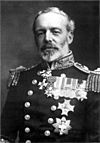 |
Rear-Admiral | Sir Christopher Cradock | 4th Cruiser Squadron | 1 November 1914 | HMS Good Hope, Coronel | Killed in action |
| Rear-Admiral | William John Grogan | HMY Sapphire II | 14 March 1915 | Portsmouth, United Kingdom | Drowned | |
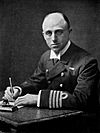 |
Rear-Admiral | Sir Robert Arbuthnot | 1st Cruiser Squadron | 31 May 1916 | HMS Defence, Jutland | Killed in action |
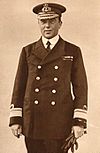 |
Rear-Admiral | Sir Horace Hood | 3rd Battlecruiser Squadron | 31 May 1916 | HMS Invincible, Jutland | Killed in action |
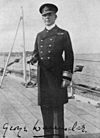 |
Vice-Admiral | Sir George Warrender | Former Commander-in-Chief, Plymouth | 8 January 1917 | London, United Kingdom | Illness |
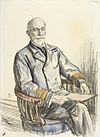 |
Admiral | Sir Frederick Hamilton | Commander-in-Chief, Rosyth | 4 October 1917 | Rosyth, United Kingdom | Illness |
| Vice-Admiral | Frank Hannam Henderson | On special service, HMS President | 26 June 1918 | Royal Hospital Haslar, United Kingdom | Operation | |
| Engineer Rear-Admiral | Francis Henry Lister | Haulbowline Dockyard staff | 20 August 1918 | Queenstown, United Kingdom | Illness | |
| Engineer Rear-Admiral | Richard James Tench | 1 November 1918 | Waterlooville, United Kingdom |
Officers Who Died After the Armistice
The fighting in World War I ended with the armistice of 11 November 1918. However, the official peace treaties took a few more years to be agreed upon. For most purposes, the British Parliament set 31 August 1921 as the official end of the war. The Commonwealth War Graves Commission also uses this date for its records. The following flag officers died between the armistice and 31 August 1921.
| Image | Rank | Name | Role | Date of Death | Place of Death | Cause of Death |
|---|---|---|---|---|---|---|
| Admiral | Frank Finnis | Retired 1909; served from 1915 as a captain in the Royal Naval Reserve | 17 November 1918 | London, United Kingdom | Illness | |
| Admiral | Herbert Lyon | Retired 1913; served from 1914 as a commodore in the Royal Naval Reserve commanding patrols at Malta | 15 March 1919 | Bighi Hospital, Malta | Illness | |
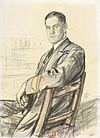 |
Vice-Admiral | Sir Trevylyan Napier | Commander-in-Chief, America and West Indies Station | 30 July 1920 | Hamilton, Bermuda | Illness |
| Vice-Admiral | Gerald Marescaux | Retired 1915; served from 1914 as a colonel in the British Army. Last position commanding British Troops, Paris. | 3 September 1920 | Royal Naval Hospital Chatham, United Kingdom | Wounds received | |
 |
Admiral of the Fleet | Sir George Callaghan | Former Commander-in-Chief, The Nore | 23 November 1920 | London, United Kingdom | Illness |
| Rear-Admiral | Henry Montagu Doughty | Former 1st Battle Squadron | 1 May 1921 | Haslar Naval Hospital, United Kingdom |


